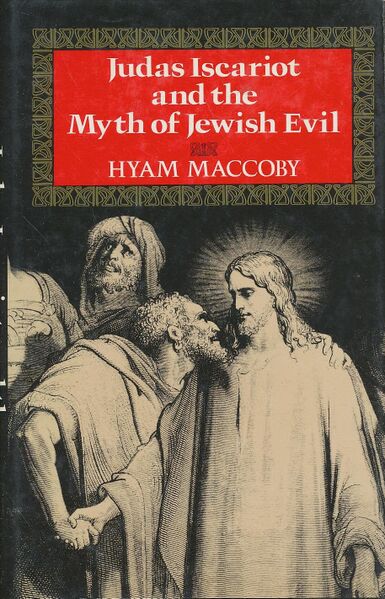File:1991 * Maccoby.jpg

Original file (914 × 1,421 pixels, file size: 434 KB, MIME type: image/jpeg)
{en} Hyam Maccoby. Judas Iscariot and the Myth of Jewish Evil. London: Halban, 1991. / New York : Free Press ; Toronto : Maxwell Macmillan Canada ; New York : Maxwell Macmillan International, 1992.
- German ed. : Judas Ischariot und der Mythos vom jüdischen Übel (2020 @1991 Maccoby), book (German ed.)
Abstract
In this speculative study of the early Church, Hyam Maccoby raises the question of whether anti-Semitism has roots in Christian theology. This would not have been a controversial question a few generations ago, yet strangely, no one formally involved in Jewish-Christian dialogue was willing to be quoted, pro or con, for attribution on the subject. This refusal to discuss a legitimate issue that should deeply concern representatives of both religious groups suggests that Maccoby has hit a nerve. And indeed, that is precisely his intention in this closely argued book about the origin, development, and posthumous career of the shadowy Biblical figure called Judas Iscariot. Maccoby begins by asking, who was Judas, and how did he become the preeminent figure of evil in Christian myth? Maccoby shows that Judas was not marked out for any special role in the earliest accounts, rather he emerges in successive versions as the fated betrayer who leads Jesus to his necessary sacrifice. The Judas story, he concludes, is thus a fabrication which has more to do with the internal quarrels of the early Church--above all with the narrative requirements of a sacrificial myth--than with the actions of any supposed historical character. This mythic role of Judas as a "sacred executioner" is central to the understanding of his story and indeed to the subsequent history of the Jews within Christian civilization. For this role was transferred to the whole Jewish people, who have been branded with precisely those vices of envy, greed, and ultimate disloyalty displayed by Judas in the Gospels. Maccoby traces this association through the literature and art of Christian Europe to the present day--but he maintains that symbols of the Christian myth have greater power in the post-theological age than we realize, precisely because our rationalistic prejudice persuades us that we are immune to subrational influence. Thus, paradoxically, Enlightenment--which Jews regarded as the key to their emancipation--may actually have intensified anti-Semitism by driving the idea of evil to the margins of acceptable discourse. And it is just this "primitive" identification of the Jews as the people of evil that the well-meaning liberal exponents of interfaith dialogue refuse to discuss.--Adapted from dust jacket.
Contents
Judas in the Western imagination -- The enigma of the early sources -- The story develops : Mark and Matthew -- Judas Iscariot in Luke and Acts -- Judas Iscariot in John -- The beginnings of folklore -- Judas and the growth of antisemitism -- Who was Judas Iscariot? -- Prince Jude : a reconstruction -- The Judas myth -- Appendix: St. John Chrysostom on Judas Iscariot.
External links
File history
Click on a date/time to view the file as it appeared at that time.
| Date/Time | Thumbnail | Dimensions | User | Comment | |
|---|---|---|---|---|---|
| current | 09:01, 25 September 2023 |  | 914 × 1,421 (434 KB) | Gabriele Boccaccini (talk | contribs) |
You cannot overwrite this file.
File usage
There are no pages that use this file.